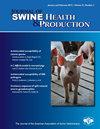HMH sked rescue system, revised deer sled, and ice fishing sled as humane on-farm handling tools to move nonambulatory grow-finish pigs on a commercial farm
IF 0.7
4区 农林科学
Q3 Agricultural and Biological Sciences
引用次数: 0
Abstract
Objective: The objective of this study was to evaluate an HMH sked rescue system, revised deer sled, and ice fishing sled as humane handling tools for moving nonambulatory pigs on a commercial wean-to-finish farm. Materials and methods: Eighteen commercial crossbred pigs received an epidural to induce a nonambulatory state. The HMH sked rescue system, revised deer sled, and ice fishing sled were tested as handling tools by 2 employees for time to place and move the pig, pig vocalization and struggle scores, and tool durability. Results: Time to place the nonambulatory pig from the start pen floor onto the handling tool, time to secure the nonambulatory pig on the handling tool, and total time were not affected by the handling tool (P ≥ .12). There was a trend for time to move the handling tool with the nonambulatory pig from the start to end pen, which included removing the pig from the handling tool and placing them onto the end pen floor (P = .06). The ice fishing sled was the most durable with no creases, rips, or holes. There were no handling tool differences for pig vocalization or struggle scores (P > .10). Changes in pig respiration rate and pig body temperature did not differ between handling tools (P ≥ .71). Implications: Under study conditions, the sked, revised deer sled, and ice fishing sled were all humane tools to move nonambulatory grow-finish pigs. Caretakers need to evaluate the best choice for their farm.HMH滑雪救援系统,改进的鹿雪橇和冰钓雪橇作为人性化的农场搬运工具,在商业农场移动非活动的生长肥育猪
目的:本研究的目的是评估HMH雪橇救援系统、改良的鹿雪橇和冰钓雪橇作为人道的处理工具,用于将商业断奶仔猪运至牧场。材料和方法:18头商品杂交猪接受硬膜外麻醉以诱导非卧床状态。HMH雪橇救援系统、改良的鹿雪橇和冰上捕鱼雪橇由2名员工作为搬运工具进行了测试,测试内容包括放置和移动猪的时间、猪的发声和挣扎得分以及工具的耐用性。结果:将不动产清管器从起始围栏地面放置到处理工具上的时间、将不动资产清管器固定在处理工具上时间和总时间不受处理工具的影响(P≥.12),其中包括将清管器从装卸工具上取下,并将其放置在围栏末端的地板上(P=.06)。冰钓雪橇是最耐用的,没有褶皱、撕裂或孔洞。在猪发声或挣扎得分方面,处理工具没有差异(P>0.05)。不同处理工具之间猪呼吸速率和猪体温的变化没有差异(P≥.71)。提示:在研究条件下,雪橇、改良鹿雪橇和冰钓雪橇都是移动不动产生长肥猪的人道工具。看护人需要评估他们农场的最佳选择。
本文章由计算机程序翻译,如有差异,请以英文原文为准。
求助全文
约1分钟内获得全文
求助全文
来源期刊
CiteScore
1.80
自引率
0.00%
发文量
29
审稿时长
>36 weeks
期刊介绍:
The Journal of Swine Health & Production (JSHAP) is an open-access and peer-reviewed journal published by the American Association of Swine Veterinarians (AASV) since 1993. The aim of the journal is the timely publication of peer-reviewed papers with a scope that encompasses the many domains of applied swine health and production, including the diagnosis, treatment, management, prevention and eradication of swine diseases, welfare & behavior, nutrition, public health, epidemiology, food safety, biosecurity, pharmaceuticals, antimicrobial use and resistance, reproduction, growth, systems flow, economics, and facility design. The journal provides a platform for researchers, veterinary practitioners, academics, and students to share their work with an international audience. The journal publishes information that contains an applied and practical focus and presents scientific information that is accessible to the busy veterinary practitioner as well as to the research and academic community. Hence, manuscripts with an applied focus are considered for publication, and the journal publishes original research, brief communications, case reports/series, literature reviews, commentaries, diagnostic notes, production tools, and practice tips. All manuscripts submitted to the Journal of Swine Health & Production are peer-reviewed.

 求助内容:
求助内容: 应助结果提醒方式:
应助结果提醒方式:


